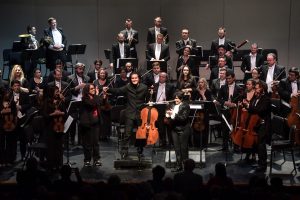
By Dennis D. Rooney
Two world premieres opened the third program of the South Florida Symphony Orchestra’s 22nd season. Zuill Bailey was soloist in the Concerto for Cello and Orchestra by Ellen Taafe Zwilich, one of two premieres on the program, both dedicated to founding Music Director Sebrina María Alfonso.
Zwilich (b. 1939), a native Floridian, is a distinguished American composer whose career broke new ground for her gender (the first woman to receive a doctoral degree in composition from the Juilliard School, the first woman to receive the Pulitzer Prize in music) and whose works are widely performed and have received numerous awards. Among them are more than a dozen concertos for strings, winds and brass.
In both her Double Concerto and Triple Concerto, the cello was featured but her newest work places it front and center. It proved a congenial vehicle for the soloist, Zuill Bailey. The sound of his Gofriller “Rosette” cello of 1693 soared splendidly in the acoustics of the Amaturo Theatre at the Broward Center for the Arts in Fort Lauderdale.
The concerto’s three linked movements suggested a meditation on melodic gestures from the American vernacular. The blues hovered over the work allusively, but the musical materials always generated multifaceted meanings that were compelling yet evanescent, ranging from gently introspective to aggressive. An agitated, bustling motto introduced the successive sections. Throughout, the mood was thoughtful but not elegiac.
Technical challenges are plentiful in the solo part, although the work’s lineaments are not those of a display vehicle. Only in the final movement did a cadenza-like episode emerge. The 47-year-old Bailey (a pupil of Stephen Kates at Peabody and Joel Krosnick at Juilliard, and currently cello professor at the University of Texas at El Paso) played it sympathetically, with attractive color and expressiveness.
Zwilich’s Concerto was preceded on the program by the other premiere, Sunset, by John D. Gottsch (b. 1950), who divides his time between Key West and Baltimore where he is professor of ophthalmology at the Johns Hopkins University School of Medicine. He is also a lifelong composer. He characterizes Sunset as ”a symphonic poem in seven connected movements that attempts to bring to musical life some of the past and future of Key West.”
The descriptive titles of the work indicate its programmatic nature. “From Ocean’s depth” represents the island’s birth. A fanfare precedes “An Island Is Born.” “Life Is Teeming” and “With Soaring Magnificent Frigates Vigilant” celebrate the abundant animal and bird life of the island, referring in the latter movement to a predatory bird (Fregata magnificens) that soars over the sea but never lands on water: The frigates presage an approaching hurricane: “For the Impending Tempest.” According to the composer, this section depicting the fury of a hurricane was actually conceived and written as Hurricane Irma swept the Florida Keys in 2017.
In the middle of this movement, there is a sudden silence representing the arrival of the eye of the storm and the movement ends as the eye passes and the rest of the hurricane arrives. In the sixth movement, “Raising the Waters,” rapid ascending musical figures represent the aftermath of the hurricane and flooding of the island, and the work ends with “As the Island Sunsets Into the Sea,” a valedictory fanfare comprised primarily of descending musical gestures.
Suggestions of other music abound in the work albeit no discernible quotations. One heard gestures reminiscent of Britten’s sea music from Peter Grimes; the Sibelius of Tapiola and the Sixth Symphony; an echo of Copland’s “Mexican” period; and the nostalgic recessionals of Richard Strauss. However diverting, the activity of the music did not disguise a mainly unsophisticated rhythmic structure, the lack of balancing lower sonorities against the pervasive brightness of the scoring, and the lack of memorable melodic materials.
Subsequent performances took place over the next two evenings, in Miami and Key West, respectively. Perhaps by the last one, the faulty intonation and tentativeness heard in the playing of Gottsch’s work was sufficiently improved to give a more assured account.
Due to a sudden indisposition, I was unable to hear the works of Beethoven and Mendelssohn on the program’s second half.
Editor’s note: Posting of this review was delayed by technical problems. The remainder of the South Florida Symphony’s season has been canceled by the coronavirus pandemic.